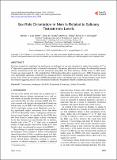Files in this item
Sex-role orientation in men is related to salivary testosterone levels
Item metadata
| dc.contributor.author | Law Smith, Miriam Jane | |
| dc.contributor.author | Deady, Denis K. | |
| dc.contributor.author | Sharp, Martin A. | |
| dc.contributor.author | Al-Dujaili, Emad A. S. | |
| dc.date.accessioned | 2014-07-08T10:31:03Z | |
| dc.date.available | 2014-07-08T10:31:03Z | |
| dc.date.issued | 2013-11 | |
| dc.identifier.citation | Law Smith , M J , Deady , D K , Sharp , M A & Al-Dujaili , E A S 2013 , ' Sex-role orientation in men is related to salivary testosterone levels ' , Journal of Behavioral and Brain Science , vol. 3 , no. 7 , pp. 518-521 . https://doi.org/10.4236/jbbs.2013.37054 | en |
| dc.identifier.issn | 2160-5866 | |
| dc.identifier.other | PURE: 130496992 | |
| dc.identifier.other | PURE UUID: d54cd15a-7dff-4754-bd46-b478ca9799ed | |
| dc.identifier.uri | https://hdl.handle.net/10023/4963 | |
| dc.description.abstract | Previous research has implicated the involvement of androgens in sex-role orientation in males, from studies of 2nd to 4th digit ratio (a purported marker of prenatal testosterone). The present pilot study investigates the relationship between salivary testosterone levels and sex-role orientation using Bem Sex Role Inventory (BSRI) scores in adult males. Twenty-one males (aged 18-24) completed the BSRI and provided saliva samples for assay. BSRI Femininity scores were significantly negatively correlated with testosterone levels; the higher the Femininity scores, the lower the testosterone levels. There was no relation of BSRI Masculinity scores with testosterone levels. Our preliminary results add to the research suggesting that sex-role orientation in males may be partially related to underlying hormone levels. | |
| dc.format.extent | 4 | |
| dc.language.iso | eng | |
| dc.relation.ispartof | Journal of Behavioral and Brain Science | en |
| dc.rights | Copyright © 2013 Miriam J. Law Smith et al. This is an open access article distributed under the Creative Commons Attribution License, which permits unrestricted use, distribution, and reproduction in any medium, provided the original work is properly cited. http://creativecommons.org/licenses/by/4.0/ | en |
| dc.subject | Testosterone | en |
| dc.subject | Personality | en |
| dc.subject | Gender | en |
| dc.subject | Femininity | en |
| dc.subject | Masculinity | en |
| dc.subject | Sex-Role | en |
| dc.subject | Androgens | en |
| dc.subject | Q Science | en |
| dc.subject.lcc | Q | en |
| dc.title | Sex-role orientation in men is related to salivary testosterone levels | en |
| dc.type | Journal article | en |
| dc.description.version | https://doi.org/Publisher PDF | en |
| dc.contributor.institution | University of St Andrews. School of Psychology and Neuroscience | en |
| dc.identifier.doi | https://doi.org/10.4236/jbbs.2013.37054 | |
| dc.description.status | Peer reviewed | en |
| dc.identifier.url | http://www.scirp.org/journal/PaperInformation.aspx?PaperID=39331#.U7u9_7EzP9p | en |
This item appears in the following Collection(s)
Items in the St Andrews Research Repository are protected by copyright, with all rights reserved, unless otherwise indicated.

